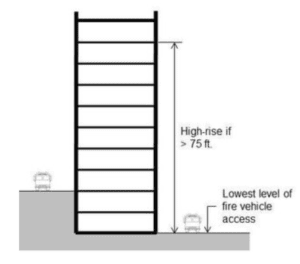Does Your Structure Measure up to a High-Rise Building?

How the High-Rise Building Has Evolved
The mighty high-rise has been a testament to civilization’s engineering and construction capabilities, though tall structures have been in existence for centuries. The Great Pyramids of Giza measure around 480 feet. The Towers of Bologna top out at about 320 feet for the tallest towers. Although, these were very tall structures, they do not perform the same functions as modern high-rises. The primary goal of a modern high-rise is to maximize the use of building square footage in areas where lot sizes are limited.
However, there is often confusion among designers, contractors, and Authorities Having Jurisdiction in deciding what structures meet the definition of a high-rise. Section 403 of the 2018 IBC provides special requirements concerning life-safety in high-rise buildings. The high-rise poses unique situations not found in buildings of lower height, from a life safety perspective. Most high-rise buildings have small floor areas making the travel distance to a protected exit well within the limitations of the various code requirements. However, long travel down the stairs is significantly slowed down compared to that of egress through a corridor and exit passageway. High-rise buildings have a large potential for property damage and loss of life for several reasons.
- It’s extremely difficult to completely evacuate the building within a reasonable time.
- Prompt rescue is difficult, and the ability to combat a fire in uppers stories from the exterior is almost impossible.
- Large number of occupants occupying the structure. In certain occupancies the occupants may be sleeping during emergencies.
- The potential for stack effect developing, which causes even deadlier conditions.
What is a High-Rise Building?

Thus, it is vitally important to be able to accurately identify a structure as a high-rise. The IBC provides a definition for high-rise in Chapter 2. A high-rise is defined as, “a building with an occupied floor located more than 75 feet (22,680 mm) above the lowest level of fire department vehicle access.” Straight forward, right? Let’s dig into this definition a little more. Where did the 75 feet rule come from? Most municipalities have apparatus that can combat fire up to about 75 feet.
Therefore, all fires above this height must be fought internally. Another school of thought considers 75 feet to be the maximum height for a building to be completely evacuated within a reasonable time. Although, the measurement is to the ground level of the fire department access, there is no requirement for how close the access must be to the building beyond the IFC requirement that fire access roads must extend within 150 feet of all portions of the building’s first floor. Therefore, the farther the fire truck is from the building, the lower the height it can reach.
Let’s take a closer look at how to determine if a structure meets the high-rise definition. Identifying the bottom point of the measurement can be difficult to establish. If a building in constructed on a site that has varying grade levels around its perimeter, the measurement is to the actual surface of the ground or pavement that is accessible by fire department vehicles. This measurement will possibly be above or below the grade plane. Grade plane is another discussion for another day.
The upper measurement point is often mixed up. This measurement is taken at the floor level and NOT the overall height of the building. What if the structure has an occupied roof? (i.e. roof decks, assembly spaces, excluding occupancy for maintenance purposes) Most AHJs would consider the roof as an “occupied floor,” thereby, making the roof and not the enclosed floor below the point of measurement.
The next time you are reviewing set of plans pay very careful attention to the elevations and fire department access provided. Your structure may be measuring up as a high-rise building.
HAVE A QUESTION ABOUT HIGH-RISE FIRE PROTECTION? CONTACT THE NFSA TODAY
Members and employees of NFSA work very closely in the codes and standards development process. Our team of experts stay on the cutting edge of fire protection issues by participating in over 250 codes and standards development committees. If you have an interest in NFSA’s mission to protect lives and property through the widespread acceptance of the fire sprinkler concept, or you simply want to get more involved in the codes and standards process with NFSA, please visit our membership page.
